UC Berkeley Press Release
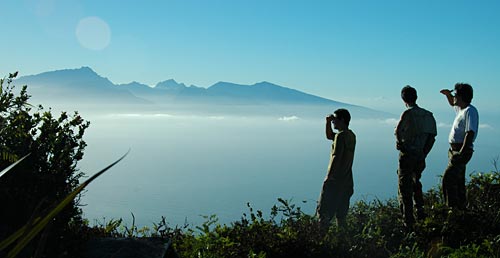 Botanists led by Jean-Yves Meyer (center) look out from Mt. Tohiea, the tallest peak on the island of Moorea, during a plant collecting expedition. In the distance is the island of Tahiti. (Dan Polhemus photo) |
$5.2 million grant from Moore Foundation funds ambitious project to barcode an entire ecosystem
BERKELEY – In the middle of the South Pacific, about 12 miles west of Tahiti, is a tropical island that soon will emerge as a model ecosystem, thanks to the efforts of a U.S.-French research team led by University of California, Berkeley, biologists.
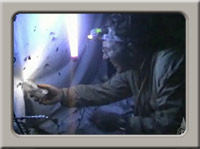 UC Berkeley biologist George Roderick talks about working on the South Pacific island of Moorea and an ambitious project to create a genetic inventory of all non-microbial life in the island's ecosystem. (2:06 min. produced by Roxanne Makasdjian/Media Relations; Moorea footage provided by Jérôme Petit, The World Conservation Union) |
"This is the first effort to catalog and barcode an entire tropical ecosystem, from the bottom of the ocean to the top of the mountains," said George Roderick, UC Berkeley professor of environmental science, policy and management, curator of the campus's Essig Museum of Entomology and co-principal investigator of the project.
"We're constructing a library of genetic markers and physical identifiers for every species of plant, animal and fungi on the island, then making that database publicly available as a resource for ecologists and evolutionary biologists around the world," he said. Roderick is a former director of the Gump Station, where the National Science Foundation has established one of its 26 Long Term Ecological Research sites (the Moorea Coral Reef LTER).
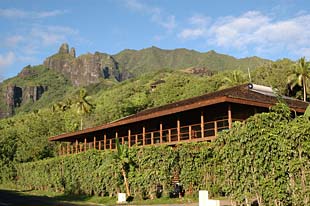 Biologists will process samples taken for the Moorea Biocode Project in this new lab building at UC Berkeley's Richard B. Gump South Pacific Research Station. (Gustav Paulay photo) |
The work will expand upon a 2005 pilot biocode project at Moorea, also funded by the Moore Foundation, which tested the feasibility of such a large undertaking. That project was limited to genetic barcoding of the fishes, geckos and selected insects.
 Specimen collection for the Moorea Biocode Project ranges from underwater, where Chris Meyer (above) collects marine invertebrates on the forereef, to the lush forests, where Joel Nitta (below), a UC Berkeley undergraduate, collects filmy ferns as part of his honors thesis work. (Photos by Jim Hayward [above] and Erica Spotswood [below]) 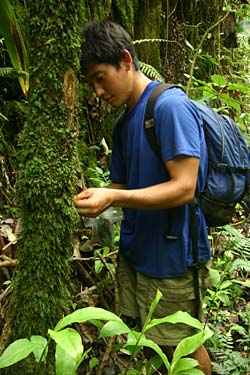 |
guts will be fair game in the full project. "We'll check the gut contents of a gecko, spider or fish to find out what it's eating," said Chris Meyer, who managed the pilot project while he was a researcher at UC Berkeley. "This information will show how organisms fit together in the ecosystem, and because we will characterize every species on Moorea, we will be able to reconstruct the entire food web. With such a tool, ecologists in French Polynesia can pioneer a whole system approach to investigating how island food webs respond to disturbance, such as when invasive species enter the picture or sea temperatures rise."
There are an estimated 5,000 plant, animal and fungal species on Moorea, although that number may change as cryptic communities and organisms are sampled and genetic markers reveal novel species. "I'd be disappointed if we don't hit at least 10,000 species," said Meyer.
The number of species on the 51-square-mile island of Moorea is small compared with that on larger islands and continents. In California, for example, the number of insect species alone tops 30,000. Yet, the researchers say Moorea provides the right balance of being small enough to be studied manageably while being sufficiently complex to reliably serve as a microcosm of the challenges faced in larger ecosystems.
Charting the state of coral reefs off the island's coast, for example, could shed light on the impact of climate change, while documenting the invasive species that have been introduced to the island would speak to the effects of globalization. Creating a record of all of the island's species can also highlight localized human-generated problems such as over-fishing, habitat destruction and pollution.
"Virtually all the ecosystems in the world are under these same stresses, and how they are responding to them is what we need to understand," said Davies, the lead principal investigator on the grant. "A model ecosystem approach to ecology will benefit conservation much like model organisms - from fruit flies to roundworms - in molecular biology have benefited medicine. There is a great deal of insight researchers can obtain about very complex systems by first studying simple ones. Much of what we learn at Moorea will be applicable elsewhere."
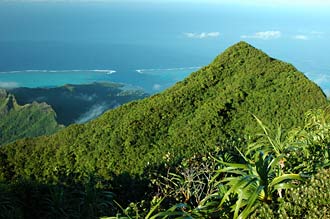 View from the top of Mt. Tohiea, the highest peak on Moorea, taken during a 2006 collecting expedition for the Moorea Biocode pilot project. (Dan Polhemus photo) |
"By comparing the genetic barcode of species on this island with those on other islands, we can get a sense of how long they've been on Moorea, and thus how they likely arrived," said Moritz. "The whole history of this island is one of invasion, and this project will help untangle a bit of that history."
At the end of the three-year project, the Moorea Biocode Project will have sequenced a whole tropical ecosystem. "Like the Human Genome Project, however, this unprecedented accomplishment is, in some ways, merely a necessary first step," said Davies. "Its goal is to accelerate progress on the larger questions: how to maintain a healthy ecosystem and what to do when things go wrong."

